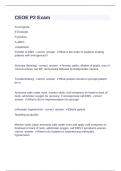CEOE P2 Exam
R-recognize
E-Evaluate
P-position
A-ABCs
I-implement
R-Refer to EMS - correct answer ✔What is the order of students treating
patients with emergencies?
Syncope (fainting) - correct answer ✔Anxiety, pallor, dilation of pupils, loss of
consciousness, low BP, tachycardia followed by bradycardia, nausea
Trendenlenburg - correct answer ✔What position should a syncope patient
be in
Ammonia salts under nose, monitor vitals, cold compress on head or back of
neck, administer oxygen for recovery, if unresponsive call EMS - correct
answer ✔What to do for implementation for syncope
orthostatic hypotension - correct answer ✔Elderly patient
Standing up quickly
Monitor vitals, place ammonia salts under nose and apply cold compress on
forehead or back of neck, administer oxygen, call EMS if symptoms worsen -
correct answer ✔What to do if patient is experiencing orthosratic
hypotension
, Hyperventilation - correct answer ✔Rapid shallow breathing, confusion,
parasthesia, shallow breathing, vertigo, chest tightness
Have patient breathe into paper bag or into their hands, hold breath and then
breathe - correct answer ✔What to do if patient is hyperventilating
Seizure/Epilepsy - correct answer ✔Excited, tremor, gasp or cry
Asthma - correct answer ✔Anxiety, coughing spasm, labored breathing
Administer Albuterol, monitor vitals, if severe administer oxygen, call EMS if
not responding - correct answer ✔What to do if patient has asthma
Type 1 allergic reaction, epi pen - correct answer ✔Anaphylaxis,
bronchospasm, bradycardia
Type IV, Benadryl - correct answer ✔Angioedema, pruiritis, urticaria
Hypoglycemia/insulin shock - correct answer ✔Sudden onset, confused,
diaphoresis, drooling, nervousness, rapid heartbeat, pallor, loss of
consciousness
Give glucose tablets, monitor vitals, call EMS - correct answer ✔What to do
for a patient with hypoglycemia
Chest pain/angina/myocardial infarction - correct answer ✔Chest pain or
tightness, dyspnea, possible shoulder pain, tachycardia, anxiety, stress




